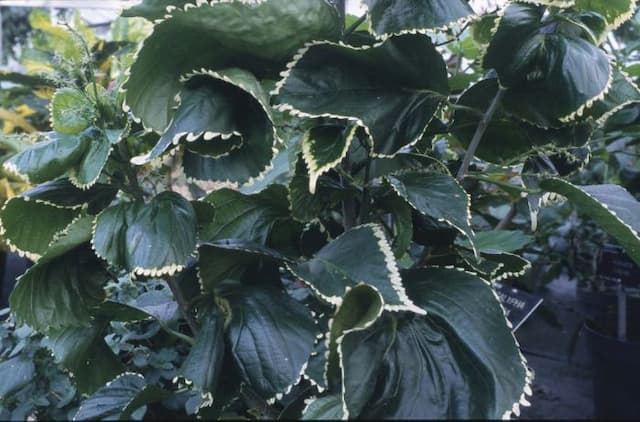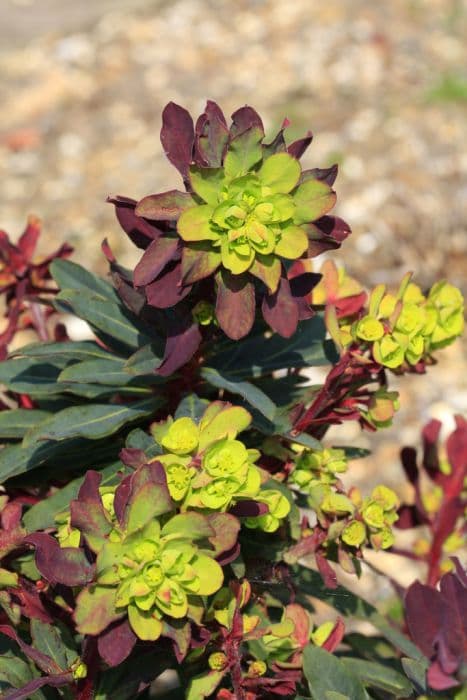Nickel’s Spurge Euphorbia seguieriana subsp. niciciana

ABOUT
Euphorbia seguieriana, commonly known as the needle spurge, has a distinct appearance characterized by its narrow, blue-green leaves that tightly cluster along its stems, forming a needle-like effect. This perennial plant features numerous stems that emerge from the base, creating a bushy aspect. Its foliage contrasts with the color of the stiff stems, which may appear as slightly woody. The tiny yellow-green flowers are inconspicuous and are structured in unique clusters known as cyathia. These flower clusters have petal-like bracts that can sometimes be mistaken for petals. The overall impression of the needle spurge is of a dense, compact plant with a spiky texture, emphasized by the slender leaves and the particular way the stems and foliage grow. It bears a milky sap that is typical of the euphorbia family, which should be handled with care as it can be irritating to skin and eyes. The needle spurge contributes to the landscape with its distinctive foliage and form, providing a sharp visual interest and texture.
About this plant
 Names
NamesFamily
Euphorbiaceae
Synonyms
Needle Spurge
Common names
Euphorbia niciciana, Euphorbia seguieriana.
 Toxicity
ToxicityTo humans
The plant in question is commonly known as Needle Spurge. Needle Spurge is toxic to humans due to its latex, a milky sap present in all parts of the plant. If ingested, the toxic components, primarily the diterpene esters found in the sap, can cause symptoms such as nausea, vomiting, diarrhea, and abdominal pain. The sap can also be an irritant if it comes into contact with skin, leading to rashes, redness, and swelling. Most notably, if the sap gets into the eyes, it can cause severe pain and potentially lead to temporary or permanent blindness. Therefore, caution is advised when handling this plant.
To pets
Needle Spurge is also toxic to pets. The milky sap of Needle Spurge can cause similar issues in pets as it does in humans. If ingested by pets, the toxic compounds can lead to symptoms such as vomiting, diarrhea, and in severe cases, more systemic effects like weakness and tremors. If the sap comes into contact with their skin, it may result in irritations and rashes. Exposure to the eyes can cause significant pain and possibly lead to vision problems. It is crucial to prevent pets from chewing on or ingesting any part of this plant and to seek veterinary attention if exposure occurs.
 Characteristics
CharacteristicsLife cycle
Perennials
Foliage type
Semi-deciduous
Color of leaves
Green
Flower color
Varies
Height
1-1.5 feet (30-45 cm)
Spread
1-1.5 feet (30-45 cm)
Plant type
Herb
Hardiness zones
5
Native area
Europe
Benefits
 General Benefits
General Benefits- Drought Tolerance: Euphorbia seguieriana subsp. niciciana is highly drought-tolerant, making it ideal for xeriscaping and dry, arid gardens.
- Low Maintenance: It requires minimal care once established, avoiding the need for regular watering or fertilizing.
- Erosion Control: Its root system helps to stabilize soil and prevent erosion, especially in sandy or rocky areas.
- Habitat for Wildlife: The plant provides shelter and the seeds are a food source for birds and other wildlife.
- Decorative Appeal: It features interesting foliage and structure, adding aesthetic value to the landscape.
- Adaptability: This species is adaptable to a range of soil types, as long as the soil is well-drained.
- Heat Resistance: The plant can withstand high temperatures, making it suitable for hot climates.
- Resilience to Pests: It is generally resistant to pests and diseases, reducing the need for chemical treatments.
 Medical Properties
Medical Properties- Euphorbia seguieriana subsp. niciciana is not commonly recognized for medicinal uses.
 Air-purifying Qualities
Air-purifying QualitiesThis plant is not specifically known for air purifying qualities.
 Other Uses
Other Uses- Euphorbia seguieriana subsp. niciciana can be used in rock gardens due to its drought-resistant nature and ability to thrive in well-drained soils.
- The latex sap of this Euphorbia can be applied as a protective coating on wooden surfaces or tools to deter pests.
- The plant's dense growth can provide habitat and cover for small wildlife, such as insects and small reptiles.
- Dried stems and leaves of Euphorbia seguieriana can be used in floral arrangements and crafts for their unique appearance.
- Due to its resilience, the plant can be used to stabilize soils and prevent erosion on slopes and barren areas.
- The striking foliage and stems can be used for dyeing fabric or paper in various shades of yellow and green.
- Euphorbia seguieriana's branching structure can inspire artists for drawing or modeling natural forms in sculptures.
- When appropriately treated, the latex sap could serve as a natural adhesive for paper-based crafts and minor repairs.
- Garden designers may use this Euphorbia as a living fence or border for aesthetic separation in landscape designing.
- The plant can serve as a study organism for educational purposes in botany and ecology, showcasing its adaptations to arid environments.
Interesting Facts
 Feng Shui
Feng ShuiThe Euphorbia seguieriana is not used in Feng Shui practice.
 Zodiac Sign Compitability
Zodiac Sign CompitabilityThe Euphorbia seguieriana is not used in astrology practice.
 Plant Symbolism
Plant Symbolism- Resilience: Euphorbia seguieriana subsp. niciciana, also known as Hungarian Spurge, often grows in tough conditions, symbolizing the ability to withstand and thrive in challenging environments.
- Protection: The milky sap of Hungarian Spurge is toxic and can cause skin irritation, making the plant a symbol of defense and protection against harm.
- Unique Beauty: With its distinctive shape and coloration, Hungarian Spurge represents the beauty that can be found in uniqueness and standing apart from the crowd.
- Purification: The genus Euphorbia is often associated with purification due to its potent sap, suggesting the plant's symbolic role in cleansing and renewal.
 Water
WaterThe Toothed Spurge should be watered deeply but infrequently, allowing the soil to dry out somewhat between waterings. This is typically equivalent to 1 inch of water every week to ten days during active growth periods in the spring and summer. Reduce watering in the fall and water sparingly in winter, providing only enough to prevent the soil from becoming completely dry, approximately 1 inch every two to three weeks depending on indoor conditions and the size of the plant.
 Light
LightToothed Spurge thrives in full sun to partial shade. It prefers a position where it can receive at least six hours of direct sunlight per day. An ideal spot would be a south or west-facing location where it gets ample sunshine with some afternoon shade to protect from the hottest part of the day.
 Temperature
TemperatureToothed Spurge is tolerant of a wide range of temperatures, but it grows best when the temperature is between 60°F and 75°F. It can withstand temperatures as low as 20°F but should not be exposed to frost. During extreme heat when temperatures soar above 85°F, it is important to ensure the plant has adequate moisture and some protection from the intense sun.
 Pruning
PruningPruning the Toothed Spurge helps maintain its shape and encourage bushier growth. It's best to prune in late winter or early spring before the onset of new growth. Prune sparingly, removing only dead or overgrown branches, and always wear protective gloves since the sap can be irritating to the skin.
 Cleaning
CleaningAs needed
 Soil
SoilEuphorbia seguieriana, commonly known as the needle spurge, thrives best in a well-draining soil mix composed of one part coarse sand, one part perlite or pumice, and one part loam. A slightly alkaline soil pH of around 7.5 is ideal for this succulent plant to ensure optimal growth.
 Repotting
RepottingNeedle spurge should be repotted every 2 to 3 years to provide fresh nutrients and to accommodate root growth. It is important to avoid repotting too frequently as this can stress the plant.
 Humidity & Misting
Humidity & MistingNeedle spurge prefers a dry environment with low humidity levels, typical of its native habitat in steppe and semi-desert regions. High humidity could contribute to rot and is to be avoided.
 Suitable locations
Suitable locationsIndoor
Ensure bright light, limited water, and good air circulation.
Outdoor
Plant in full sun, well-draining soil, and protect from heavy rain.
Hardiness zone
6-9 USDA
 Life cycle
Life cycleEuphorbia seguieriana subsp. niciciana, commonly known as Russian Spurge, begins its life as a seed that germinates in favorable conditions, preferably in well-drained soils and sunny locations. The seedling stage follows, where it establishes roots and shoots, gradually developing into a mature plant with characteristic bluish-green foliage and a tough, woody base. During its growth stage, Russian Spurge produces small, inconspicuous flowers in the summer, which are surrounded by showy, yellow-green bracts that attract pollinators. After pollination, the plant develops fruit, which are capsules that release seeds upon maturity. The plant exhibits a period of dormancy in colder climates during the winter months. With its ability to self-seed, Russian Spurge can perpetuate its life cycle annually, spreading to occupy more space within its habitat.
 Propogation
PropogationPropogation time
Spring-Early Summer
Propogation: Euphorbia seguieriana subsp. niciciana, commonly known as Russian Spurge, is most effectively propagated through seed. The optimal time to sow seeds for Russian Spurge is spring, after the last frost, when the soil has warmed to at least 50 degrees Fahrenheit (10 degrees Celsius). To propagate, distribute the seeds on well-drained soil and lightly cover with soil. Ensure that the soil is kept evenly moist until germination, which typically occurs within two to three weeks under the right temperature conditions. Once the seedlings have grown enough to handle, usually when they have at least a couple of sets of true leaves, they can be transplanted to their final location in the garden.



![Spurge [Blackbird]](/_next/image?url=https%3A%2F%2Fplants-admin.emdemapps.com%2Fimages%2Fplants%2F%2Fimages%2F604b535f37783.png&w=640&q=75)





